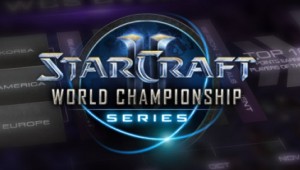Will We Soon See A SC2_NVIDIA_GeForce_GG Bowl?
 So this weekend I watched a fair amount of the Starcraft 2 World Championship Series Season 1 championships online. My appetite for SC2 was whet a few days earlier when I had one of my first multiplayer play sessions here at the lab, and I really enjoyed playing. Spending as much time as I do watching, researching, and writing about so-called “traditional” sports, I saw the major Sc2 tournament as an opportunity to learn some about the game, and the sport surrounding it.
So this weekend I watched a fair amount of the Starcraft 2 World Championship Series Season 1 championships online. My appetite for SC2 was whet a few days earlier when I had one of my first multiplayer play sessions here at the lab, and I really enjoyed playing. Spending as much time as I do watching, researching, and writing about so-called “traditional” sports, I saw the major Sc2 tournament as an opportunity to learn some about the game, and the sport surrounding it.
I was watching the matches via stream, as most were, either on my iPad, on my computer, or for a brief bit, on my big TV via the Xbox. Twitch was my primary portal for accessing the streams on all devices. I did not really stick to any one channel for the matches; I was stream surfing. For a while, I was watching the WCS being streamed live from Korea on the OGN streams courtesy of OSL Stream 2, with Day[9] and Apollo alternating with DoA and Monte Cristo, sometimes conducting interviews on a love seat. But occasionally I’d switch over to the GOMTV, GSL stream 1 of the WCS which featured Artosis and Tasteless. They were good too. But if I was really in my surfing groove, sometimes I would fly over from the OGN OSL streams to the GOMTV GSL stream of Wolf and Khaldor because I really like Khaldor’s german accent. Some of the streams played cheezy MMA style metal, others played Daft Punk. There was no strong sense of production identity tying the streams together. Some casters wore suits, others t-shirts. What are all the acronyms standing for, you ask? Well, the WCS is the World Championship Series which is run by Blizzard, a game company. OGN is Ongamenet which is a South Korean tv station that also sponsors the OSL, or Ongamenet Starleague which I think is related to the WCS, but I don’t know how. GOMTV is another South Korean based online network that sponsors the GSL, the Global Starcraft 2 League, which I think is also related to the WCS somehow.
If at this point your head is spinning, then you are not alone. Here we’ve got two “leagues” on two “networks” streaming a “season” of a championship “series” that is run by a game publisher. I found myself quickly confused by the lack of a central governing body that supervised the whole event, including the broadcasts. Networks like OGN or GOMTV, which sponsor their own leagues, were streaming a tournament run by a different company, and on multiple channels! Add to this my novice inability to quickly parse “handles” for players and casters, names like EG_Stephano_RC, Woongjin Stars sOs, and STX SOUL INnoVation, and I was getting lost pretty quickly. It all struck me as so different from traditional sports exclusive broadcasting deals. ESPN has Monday Night Football games from the NFL until the contract expires, and nobody else can show it. From my background with traditional sports and exclusivity, I was surprised — as a competitive Starcraft 2 novice, I was lost — and as a sports media researcher, I was curious.
Talking the situation over with Philip the next day at work, we thought that an interesting domain of comparison would be NCAA sports, and specifically the evolution of the Bowl games. For those unfamiliar, here is a very brief history:

Bowl games began with the Rose Bowl in Pasadena California, which featured an end of the year game between long-distance teams who were not likely to have played against one another because of the distance and conference affiliation. Colleges are organized into semi-regional conferences such as the Big Ten, the Pac-12, or the SEC. In the first half of the 20th century, the game was played between the winner of the Pacific Coast Conference and an opponent from the east. Eventually, the Rose Bowl would be played between the champions of the Pac-10 and the Big Ten. A commercial success, the Rose Bowl spawned other popular bowl games featuring championships between winners of different conferences. Soon enough, the turning of the calendar saw the arrival of the Cotton Bowl, the Sugar Bowl, and the Orange Bowl. But with so much money at stake, and with so many collegiate teams, why stop there? What we have today is a glut of sponsored bowls ranging from the Tostitos Fiesta Bowl, to the Little Ceasars Pizza Bowl and even the Beef ‘O’ Brady’s Bowl.
Soon enough, the NCAA had a problem. With teams ranked based on a computerized system, and bowls plucking teams from different conferences to play a final game, how could the league declare a single team as National Champions. The earliest and oldest system in NCAA football was to use math and polls. The polls, were of course not necessarily independent, and were often sponsored. It’s worth taking a look at the wikipedia page about it to see just how complicated it has been over the past century.
I see some of the same disorganization with the Starcraft 2 championship series, and I mean that in a descriptive, not pejorative way. There is no real sense that any single governing body like an NCAA has control of the Starcraft 2 tournaments, and that leaves a lot more room for interesting experimentation. There seems to be a similar sort of land grab for the signature event and coverage. I think part of what may be complicating things in even more interesting ways is the significant player and team overlap between leagues. Traditional sports are marked by collectivisation, and exclusivity which have helped them to grow into commercial powerhouses immune from anti-trust litigation. Imagine if the Boston Red Sox ownership decided that the team was going to play in both Major League Baseball and in the Nippon Professional Baseball league in Japan. How would that even work? Who would benefit from the revenue earned? Who would have rights to broadcast the games?
There may be a better comparison here with the history of profesional tennis. Prior to the organization of the Association of Tennis Professionals (ATP) in 1972, there were two tennis leagues: the National Tennis League (NTL) and World Champion Tennis (WCT). Players signed with individual leagues that negotiated licenses for players to perform at specific tournaments. To counteract the control held by the leagues, the International Lawn Tennis Federation (ILTF) organized a Grand Prix series of tournaments including the French Open, Wimbeldon, and the US Open.
So for those following along at home, we’ve first got the NTL, the WCT, and then the ILTF Grand Prix — head swimming yet (is this sounding familiar?). It took the players, frustrated with exclusive contracts prohibiting play, to organize the ATP, a syndication of players not promoters, to start the ball rolling toward open tournaments. The irony of course is now the ATP is the governing body that controls the highest stake in professional tennis.
I think there are probably many other examples of the evolution of traditional sports organizations that relate to the burgeoning e-sports scene. On the one hand, I think it is useful to see the parallels. On the other, I am careful not to suggest that traditional sports have it all figured out and that they are setting some kind of standard that e-sports can evolve into. The exclusivity and centrality of professional sports in america have a very complex history that is informed as much by the ideologies and goals of the Sports Media Industrial Complex as by any collective commitment to a supposed integrity of the games as such. If there is any lesson to be learned from the evolution of traditional sports, it is how powerful commercial interests can be in shaping the way the organizational structures of a sport is shaped, and who those organizations ultimately serve. For anyone interested in this topic, I highly recommend reading TL Taylor’s Raising The Stakes, which offers a tremendously detailed and thoughtful first look at the early development of eSports communities and economies.
It is my hope that as the critical discourse around eSports continues to evolve, that scholars will look to the histories of so-called traditional sports, and the contemporary shape of those sport institutions as examples of where eSports may be headed should major stakeholders in eSports mirror those in traditional sports. Perhaps more importantly, as eSports is growing rapidly, maybe appropriate interventions can be made to ensure that ethical mistakes repeatedly made in commercialized traditional sport are avoided or ameliorated in the growth of eSport.


